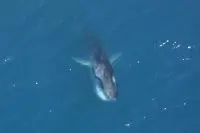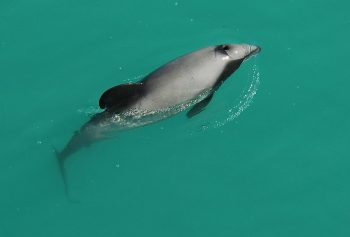After the blue whale, Fin Whale (Balaenoptera Physalus) is the world’s second largest mammal. It is among one of the 15 species of baleen whales. It can swim at a speed of 23 to 25 mph.
It has brown-to-gray appearance. It has long, slender body and a tall spout of water (as high as 20 feet) comes out of its blowhole. Due to its speed, it is known as ‘the greyhound of the sea’. It has a recognizable dorsal fin of up to 60 centimeters in length. It has broad tail while the flippers thin out at the end.
Its size varies with different habitats. To the North, female fin whales can grow up to 66 feet in length and weighs around 111,000 pounds. To the South, female whales are up to 72 feet in length and weighs up to 139,000 pounds. Males are relatively shorter than females. The maximum size of the fin whale ever recorded is 85 feet.
It has a lifespan of more  than 94 years.
than 94 years.
Typically, a female fin whale reaches maturity at 6 to 12 years. However, it does not fully matures until 25 to 30 years of age. The reproductive cycle is 2 to 3 years. Breeding occurs in winter. Female fin whales continue to nurse their calves for 12 months. The mother weans (stop feeding) her calf after 7 months.
A female fin whale gives birth to just 1 calf. A newborn has a size of up to 20 feet.
The northern fin whale is widely distributed from the Gulf of Mexico to Spitsbergen.
It inhabits in cool and temperate waters around the world’s major oceans.
Fin whale has plates of baleen inside its mouth that filters out food. It readily feeds on small fishes like krill, crabs, shrimp, squid, lobsters and copepods.
Fin whales are hunted to get oil and blubber. They are often killed by colliding with the ships.
Orcas are the only known predators of fin whales.
Other Names: Razorback Whale, Herring Whale, Finback Whale, Giant Minke Whale and Common Rorqual Whale





